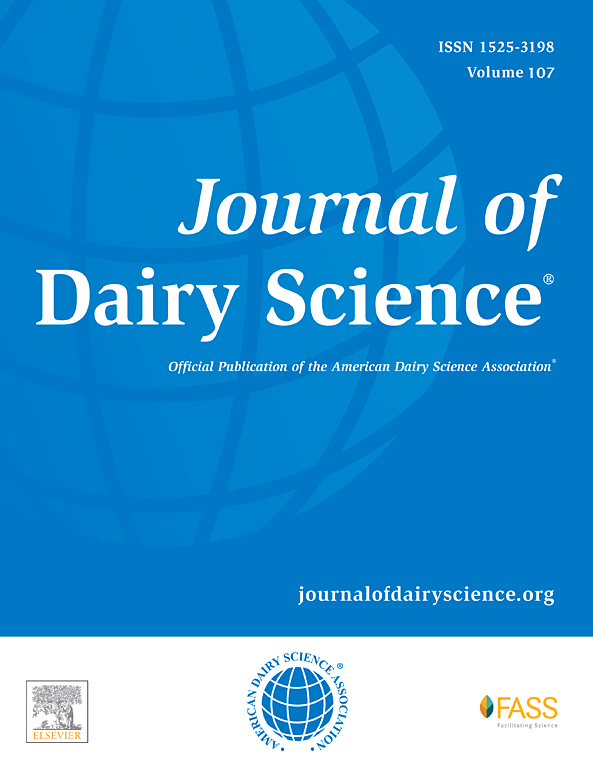近距离饲粮能量含量及产后饲喂保护瘤胃赖氨酸和蛋氨酸对荷斯坦奶牛生产性能和健康的影响。
摘要
本试验旨在研究以相同aa - me比(赖氨酸3.21 g/Mcal,赖氨酸1.21 g/Mcal)和不同浓度NEL饲喂过瘤胃蛋氨酸(RPM; KESSENT M, Kemin Industries Inc.,得梅因,IA)和过瘤胃赖氨酸(RPL; LysiGEM, Kemin Industries Inc.,得梅因,IA)预备料对奶牛生产性能的影响。采用完全随机区组设计,将62头多产荷斯坦奶牛分为3种饲粮处理中的1种。预备期(-21 d至预期产犊),分别饲喂控制能(CE)饲粮(麦秸基础饲粮,1.45 NEL[2.33 ME] Mcal/kg DM + RPL和RPM (CEAA;饲粮DMI的0.15% RPL和0.09% RPM)、不含RPL和RPM的CE饲粮(对照;CENAA)或高能(HE)饲粮(玉米青贮基础饲粮,1.71 NEL[2.70 ME] Mcal/kg DM] + RPL和RPM (HEAA; RPL 0.22%和RPM 0.12%)。产后,奶牛在不添加RPL和RPM (CENAA, n = 19)或添加RPL和RPM (CEAA, n = 21, HEAA, n = 21;饲粮DMI的0.38% RPL和0.15% RPM)的情况下,饲喂相同的泌乳TMR (1.73 NEL[2.71 ME] Mcal/kg DM),直至70 DIM。奶牛每天挤奶2次,从第2天至70 DIM,每周取1次奶样,记录产奶量和DMI。在-7±4.7、28±1.6和70±2.1 DIM时采血,比较两种治疗对照(CENAA与CEAA、CEAA与HEAA)。泌乳第1 ~ 4周,HEAA组奶牛ECM(50.5±1.77 kg/d)高于CEAA组(45.7 kg/d、1.82 kg/d和-0.36),泌脂量(2.04±0.09 kg/d)和BCS损失(-0.71±0.14)高于CEAA组(45.7 kg/d、1.82 kg/d和-0.36)。在泌乳第1 ~ 4周,CEAA组奶牛的乳中蛋白质比例(3.43%±0.07%)高于CENAA组奶牛(3.26%±0.07%)和HEAA组奶牛(3.24%±0.07%)。第5 ~ 10周,CEAA组奶牛乳蛋白比例(2.89%±0.05%)高于CENAA组奶牛(2.72%±0.05%)。CEAA组的血浆Met浓度(24.7±1.65µM)高于CENAA组(19.8±1.65µM)。CEAA组奶牛产后血浆赖氨酸(81.1±3.35µM)和Met(39.5±2.04µM)浓度分别高于CENAA组(71.5±3.35µM和19.5±2.04µM)。综上所述,在赖氨酸含量为3.21 g/Mcal和蛋氨酸含量为1.21 g/Mcal的条件下,饲喂HE饲粮对奶牛体成分的影响可能低于饲喂CE饲粮,而饲喂RPL和RPM预备料比不饲喂RPL和RPM的奶牛生产性能更好。This experiment was conducted to determine the effects of feeding rumen-protected Met (RPM; KESSENT M, Kemin Industries Inc., Des Moines, IA) and rumen-protected Lys (RPL; LysiGEM, Kemin Industries Inc., Des Moines, IA) prepartum at the same AA-to-ME ratio (3.21 g/Mcal of Lys and 1.21 g/Mcal of Met) with different concentrations of NEL on the performance of dairy cows. Sixty-two multiparous Holstein cows were assigned to 1 of 3 dietary treatments in a randomized, complete block design. Prepartum (-21 d to expected calving), cows were fed a controlled-energy (CE) diet (wheat straw based diet, 1.45 NEL[2.33 ME] Mcal/kg of DM] with RPL and RPM (CEAA; 0.15% RPL and 0.09% RPM of dietary DMI), CE diet without RPL and RPM (control; CENAA), or high-energy (HE) diet (corn silage-based diet, 1.71 NEL[2.70 ME], Mcal/kg of DM] with RPL and RPM (HEAA; RPL 0.22% and RPM 0.12% of dietary DMI). Postpartum, cows received the same lactation TMR (1.73 NEL[2.71 ME] Mcal/kg of DM) without RPL and RPM (CENAA, n = 19) or with RPL and RPM (CEAA, n = 21; and HEAA, n = 21; 0.38% RPL and 0.15% RPM of dietary DMI) until 70 DIM. Cows were milked twice daily, and milk samples were taken once a week from d 2 to 70 DIM. Milk yield and DMI were recorded daily. Blood samples were taken on -7 ± 4.7, 28 ± 1.6, and 70 ± 2.1 DIM. Two treatment contrasts (CENAA vs. CEAA and CEAA vs. HEAA) were compared. Cows in HEAA had higher ECM (50.5 ± 1.77 kg/d) and tended to have greater fat yield (2.04 ± 0.09 kg/d) and BCS loss (-0.71 ± 0.14) during wk 1 to 4 of lactation than cows in CEAA (45.7 kg/d, 1.82 kg/d, and -0.36, respectively). Cows in CEAA tended to have a higher protein proportion in milk (3.43% ± 0.07%) than cows in CENAA (3.26% ± 0.07%) and cows in HEAA (3.24% ± 0.07%) during wk 1 to 4 of lactation. Cows in CEAA had higher milk protein proportion (2.89% ± 0.05%) than cows in CENAA (2.72% ± 0.05%) during wk 5 to 10. Plasma Met concentrations prepartum were greater for cows in CEAA (24.7 ± 1.65 µM) than cows in CENAA (19.8 ± 1.65 µM). Cows in CEAA had higher plasma Lys (81.1 ± 3.35 µM) and Met (39.5 ± 2.04 µM) concentrations postpartum than cows in CENAA (71.5 ± 3.35 µM and 19.5 ± 2.04 µM, respectively). In conclusion, feeding a HE diet may have negatively affected the cows' body composition compared with cows fed a CE diet when both diets were formulated at 3.21 g/Mcal of Lys and 1.21 g/Mcal of Met, whereas, feeding RPL and RPM prepartum improved cows' performance compared with cows that were not fed RPL and RPM.

 求助内容:
求助内容: 应助结果提醒方式:
应助结果提醒方式:


